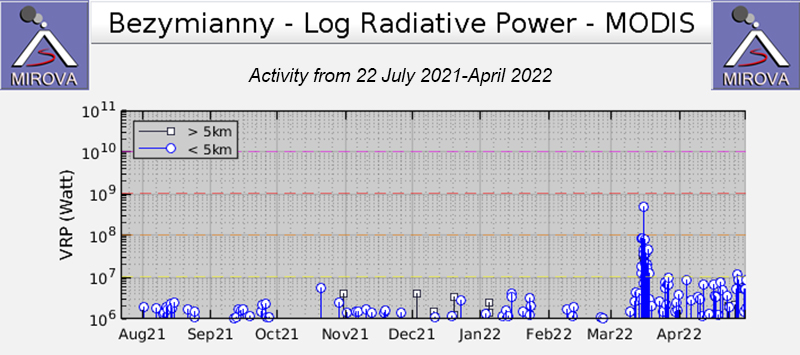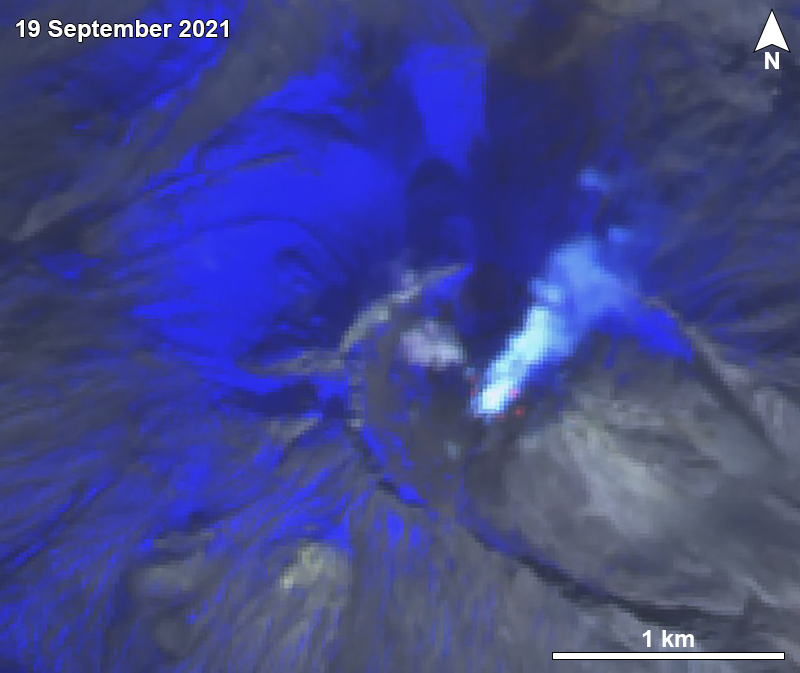Report on Bezymianny (Russia) — May 2022
Bulletin of the Global Volcanism Network, vol. 47, no. 5 (May 2022)
Managing Editor: Benjamin Andrews.
Edited by Kadie L. Bennis.
Bezymianny (Russia) Strong explosion with ash plumes, pyroclastic flows, and incandescence during 15-16 March 2022
Please cite this report as:
Global Volcanism Program, 2022. Report on Bezymianny (Russia) (Bennis, K.L., and Andrews, B., eds.). Bulletin of the Global Volcanism Network, 47:5. Smithsonian Institution. https://doi.org/10.5479/si.GVP.BGVN202205-300250
Bezymianny
Russia
55.972°N, 160.595°E; summit elev. 2882 m
All times are local (unless otherwise noted)
Bezymianny is located on the Kamchatka Peninsula as part of the Klyuchevskoy volcano group. Historical eruptions dating back to 1955 were characterized by dome growth, explosions, pyroclastic flows, ash plumes, and ashfall. The current eruption period began in May 2010, with recent activity consisting of frequent gas-and-steam emissions and weak thermal anomalies at the summit crater (BGVN 46:09). This report covers a strong explosion during 15-16 March 2022, which included ash plumes, block-and-ash avalanches, pyroclastic flows, and dome incandescence. In addition, similar low activity of gas-and-steam emissions and a frequent weak thermal anomaly at the summit crater occurred during September 2021 through April 2022 based on weekly and daily reports from the Kamchatka Volcano Eruptions Response Team (KVERT) and satellite data.
Activity during this reporting period prior to 15 March 2022 was relatively low, and according to KVERT, primarily consisted of persistent gas-and-steam emissions and weak thermal anomalies in the summit from the growing lava dome, though they were often obscured by clouds. The MIROVA (Middle InfraRed Observation of Volcanic Activity) volcano hotspot detection system based on the analysis of MODIS data showed intermittent low-power thermal anomalies during mid-September through March 2022 (figure 47). Some of these weak anomalies were visible in infrared satellite imagery on clear weather days; on 19 September the anomalies were accompanied by a gas-and-steam plume that drifted NE (figure 48). Two anomalies were observed during late October and three during mid-December. A brief spike in activity was recorded in mid-March in MIROVA data and the frequency and strength of the anomalies remained higher than the previous months through April.
During March 2022, activity increased slightly. On 15 March an ash plume was visible in satellite images at 0310 that rose to 4.9 km altitude and drifted 90 km W, indicating renewed explosive activity. By 0600 ash plumes rose to 6.1 km altitude and drifted S. Ash continued to be reported throughout the day; at 1322 they rose to 8.2 km and drifted SW. Satellite images showed block-and-ash flows descending the SE flank to the base, generating dark brown ash plumes. Thermal anomalies were visible at the summit and at the end of the flow. As a result, KVERT raised the Aviation Color Code (ACC) to Orange (the second highest level on a four-color scale). Activity intensified at 0053 on 16 March; ash plumes rose to roughly 12 km altitude and drifted more than 1,300 km NW and then NE. Activity during this time was also characterized by pyroclastic flows that descended the S, W, and N flanks. A large thermal anomaly was visible through 18 March, indicating continuing lava dome growth. On 23 March the ACC was lowered to Yellow. Dome collapses were detected on 25 and 31 March and ash clouds rose to 4 km altitude that drifted 40 km E and 20 km SW, respectively. Strong fumarolic activity, an incandescent lava dome, and avalanches were reported daily through April.
Geological Summary. The modern Bezymianny, much smaller than its massive neighbors Kamen and Kliuchevskoi on the Kamchatka Peninsula, was formed about 4,700 years ago over a late-Pleistocene lava-dome complex and an edifice built about 11,000-7,000 years ago. Three periods of intensified activity have occurred during the past 3,000 years. The latest period, which was preceded by a 1,000-year quiescence, began with the dramatic 1955-56 eruption. This eruption, similar to that of St. Helens in 1980, produced a large open crater that was formed by collapse of the summit and an associated lateral blast. Subsequent episodic but ongoing lava-dome growth, accompanied by intermittent explosive activity and pyroclastic flows, has largely filled the 1956 crater.
Information Contacts: Kamchatka Volcanic Eruptions Response Team (KVERT), Far Eastern Branch, Russian Academy of Sciences, 9 Piip Blvd., Petropavlovsk-Kamchatsky, 683006, Russia (URL: http://www.kscnet.ru/ivs/kvert/); Tokyo Volcanic Ash Advisory Center (VAAC), 1-3-4 Otemachi, Chiyoda-ku, Tokyo 100-8122, Japan (URL: http://ds.data.jma.go.jp/svd/vaac/data/); MIROVA (Middle InfraRed Observation of Volcanic Activity), a collaborative project between the Universities of Turin and Florence (Italy) supported by the Centre for Volcanic Risk of the Italian Civil Protection Department (URL: http://www.mirovaweb.it/); Sentinel Hub Playground (URL: https://www.sentinel-hub.com/explore/sentinel-playground).



